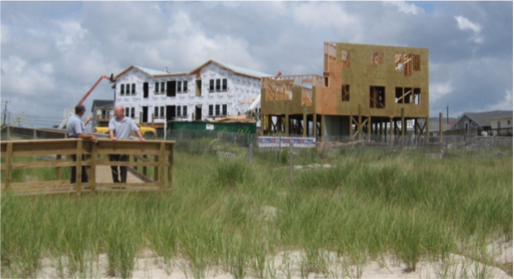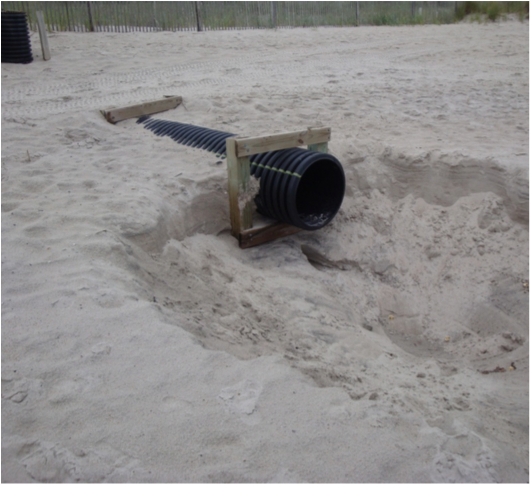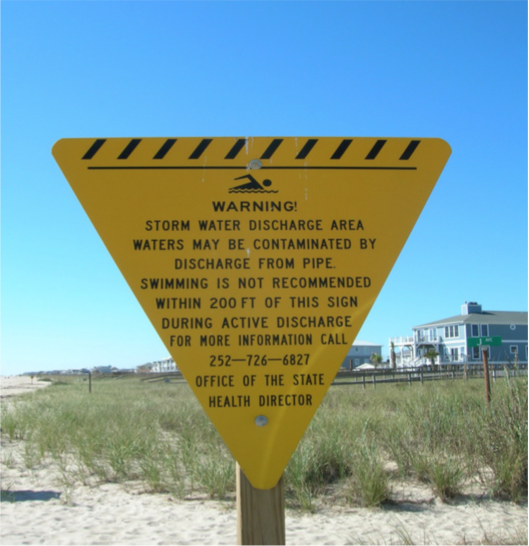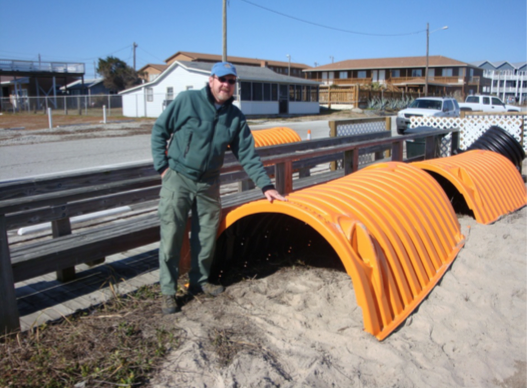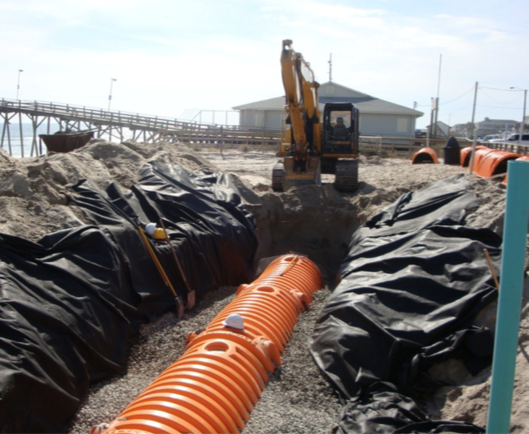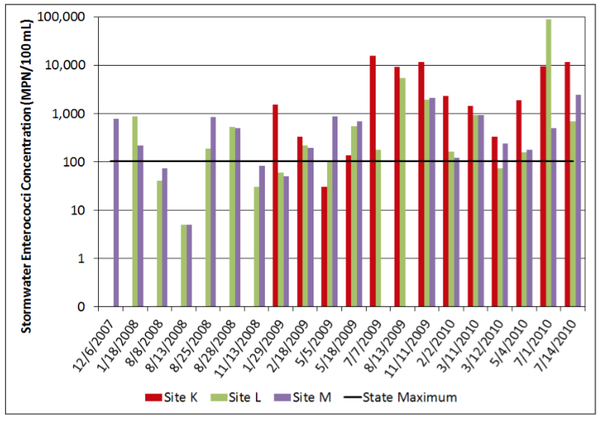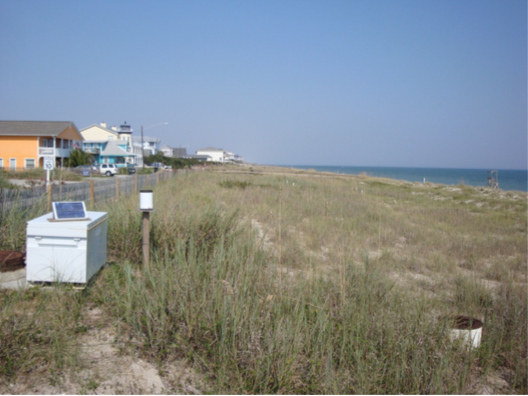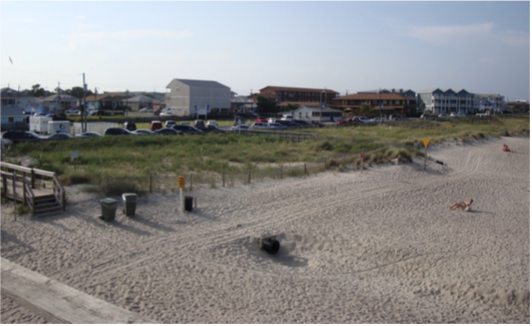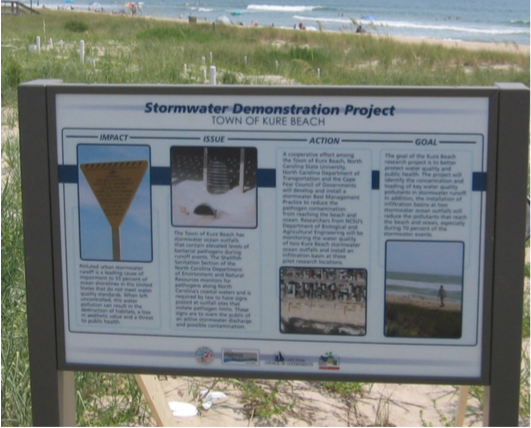Introduction
Before stormwater was recognized as a major contributor to the transport and delivery of pollutants to surface waters, many coastal towns constructed storm sewer systems that discharged runoff without treatment onto the beach or into the ocean. Untreated stormwater often contains high levels of bacteria, which could place swimmers at risk of illness after a rainfall. An innovative Dune Infiltration System (DIS) has been developed
to help prevent the polluted stormwater from reaching the ocean. The DIS reduces out flows from existing stormwater beach discharge pipes by diverting stormwater beneath the sand dunes. As the stormwater in filtrates into the subsurface sand, bacteria are filtered as they move with groundwater beneath the dunes. Three of these systems have been installed in Kure Beach, NC, and have been highly successful in reducing stormwater discharge to the recreational beach areas. The goal of this factsheet is to introduce this technology to coastal towns that want to reduce the potential impact of stormwater discharge to their beaches.
Compared to most states, coastal water quality in North Carolina is relatively high, ranking fourth in the nation according to the 2012 National Resource Defense Council’s Testing the Waters report (NRDC, 2012). But as population and tourism continue to increase near our beaches, new development and increased imperviousness generate more stormwater runoff. Houses, hotels, and parking lots are the primary impervious surfaces associated with coastal development (Figure 1), but new or improved highway and bridge systems that enable residents and tourists to reach these popular destinations also produce runoff.
If you have noticed an exposed pipe on the beach, chances are it was there to discharge stormwater (Figure 2). Stormwater management plans for many coastal towns were developed years ago.
Many towns have existing infrastructure that allows the stormwater to flow into sounds or the ocean through stormwater discharge pipes. These pipes can be numerous and vary in size, depending on the watershed area and land-use characteristics. Pipes that discharge to beaches can be fully exposed or covered with sand during various times of the year.
It has been well documented that stormwater carries pollutants that can be detrimental to the aquatic environment and to human health. This places environmental pressure on our coastal water resources and increases health concerns for people who use these waters for recreational purposes. The main human health concerns come from fecal bacteria that are washed into stormwater systems following storms. Fecal bacteria originating from the intestines of warm-blooded animals (birds, mammals both domesticated and wild, and humans) pose health risks. The NC Recreational Water Quality Program (NC RWQ), which monitors about 240 coastal locations, has shown that after rainfall events, discharge from these pipes often exceeds state and federal bacteria limits considered safe for human contact. Direct human contact with the stormwater or the area that receives the discharge can lead to symptoms of gastrointestinal, respiratory, ear, eye, nose, and skin infections (Griffin et al., 2003). In an effort to protect swimmers, the NC RWQ has an extensive water-quality sampling protocol that allows advisories and alerts to be issued when bacterial limits are exceeded. Beaches commonly have signs posted warning swimmers not to go near these stormwater discharge pipes (Figure 3). Obviously, coastal towns that have frequent advisories could eventually see a downturn in tourism and its associated revenue. Also, despite sign postings and advisories, the warnings are often unheeded (Figure 4), so reducing the frequency of untreated stormwater discharge to beach areas should be a priority.
A Potential Solution – The Dune Infiltration System
Sand filters have proved to be an effective means to capture bacteria in stormwater (Galli, 1990; Barrett, 2003) and are rated “High” as a stormwater control measure (SCM) for bacteria removal by the North Carolina Division of Water Quality (2007). Many North Carolina beaches have extensive sand dune systems that could be used to filter stormwater in a manner similar to constructed sand filters. Diversion of stormwater from existing pipes and into the dunes was the principle that guided the development of the Dune Infiltration System (DIS).
How does it work?
Before these coastal areas were developed, rainfall easily infiltrated into the sandy soils common to these locations, and portions recharged shallow groundwater. The DIS is designed to recapture this natural process by collecting stormwater runoff and providing an opportunity for infiltration into the sand. To accomplish this, flow from the existing beach discharge pipes is diverted into open-bottomed chambers located beneath the sand dunes. Once it enters the chambers, the stormwater in filtrates into the sand and spreads out laterally beneath the dunes. It mixes with the groundwater, which then moves downslope beneath the surface of the sand towards the ocean. The groundwater mixed with the stormwater then discharges slowly beneath the ocean. Bacteria concentrations in the stormwater are immediately diluted by the groundwater. As it moves with the groundwater, bacteria can then be filtered between particles of sand beneath the surface of the dunes, where they eventually die off due to environmental stresses and predation by other microorganisms (Hathaway and Hunt, 2008). Like other SCMs, it would be impractical to design a DIS large enough to capture all runoff produced from every storm. Therefore, during extremely intense rainfall events, stormwater exceeding the DIS capacity is allowed to bypass the system and discharge to the ocean through the existing discharge pipe.
Is it difficult to design and construct?
The DIS was developed to be a low-cost, low-tech system that could be easily designed by an engineer and implemented by the public works department of any coastal town. Installation of the system is no more difficult than any common stormwater, water distribution, or sewer project that towns frequently construct or repair. The ideal site for the DIS has an elevated dune system with an annual mean water table that is several feet below the surface. Since the system will be located within the dunes (which is in the Ocean Hazard Area of Environmental Concern (AEC)), a Coastal Area Management Act (CAMA) minor development permit must be granted by the NC Division of Environment and Natural Resources Coastal Resources Commission (CRC). This permit must be obtained before the project can begin, and it will authorize the temporary disturbance to the dune system.
A watershed assessment by an engineer must be completed to determine runoff rates that will enter the DIS from a storm of selected rainfall intensity. Since the system relies on in filtration, the ability of the sand to transport water (hydraulic conductivity) must also be determined by direct measurement, or estimated based on local soil survey data. Values should be high, ideally exceeding 50 inches per hour. Darcy’s equation (Haan et al., 1994) can then be used as a simple estimate to determine the area required for in filtration for the targeted storm event. The number of chambers required to provide the area needed for in filtration can then be calculated, but this number can vary depending on the manufacturer and type of chamber chosen. More detailed information on design can be found in Bright et al. (2011), Price (2011), and Price et al. (2012).
To divert stormwater from the beach discharge pipe into the chambers, a diversion can be placed either in a vault buried within the dunes or by retrofitting an existing stormwater drop inlet upslope of the dunes. Once diverted, the stormwater is transported to the chambers through a pipe distribution system, appropriately sized and installed at a proper slope to accommodate calculated peak flow rates. Larger pipe sizes are favored to reduce the potential for clogging, and multiple clean-out pipes should be incorporated in the distribution system to facilitate maintenance. To provide an outlet for the bypass flow, existing beach discharge pipes should be left in place and connected to the downstream end of the diversion structure.
Open-bottomed chambers available on the market are generally constructed of high-density polyethylene (HDPE), which makes them sturdy but lightweight (Figure 5). They can be purchased in various sizes and arranged beneath the dunes in a number of ways. Based on our current experience, however, using larger chambers arranged in a linear fashion parallel to the ocean currently appears to be the most efficient method to disperse the stormwater across the dune (Figure 6). Note the diversion, the distribution pipe, and the two banks of chambers installed at a depth of 5 ft in a linear fashion parallel to the beach.
To install the chambers, a trench through the dunes must be excavated down to a target elevation, generally dictated by the elevation of the stormwater beach discharge pipe that enters the dunes. As the trench is dug with a backhoe, a 12-in.-deep layer of gravel is poured into the bottom to provide increased in filtration and system stability. The chambers are then placed on top of the stone layer (Figure 7). After all of the chambers are installed and secured, they are covered with a geotextile fabric to reduce sand intrusion around the top and sides. The chambers are then covered with a minimum of 1.5 ft of sand and replanted with native dune vegetation.
With proper planning, these systems can be installed in about one week by a crew that includes five to eight public works staff and a qualified backhoe operator. January through March is the best time to install these systems because it avoids sea-turtle nesting season (between May and October in North Carolina) and is the low season for tourists. Constructing the system in the late winter also minimizes the time that the disturbed dune areas remain unvegetated, as dune vegetation should be replanted in the spring (Rogers and Nash, 2003). Replanting can be accomplished by the public works crew, by volunteers, or by a local company who specializes in dune restoration.
Kure Beach, NC – A Demonstration Study
The Town of Kure Beach was proactive in looking for ways to reduce stormwater entering its beach areas. The town, the NC Department of Transportation, and the NC State University Biological & Agricultural Engineering department began a partnership in 2005 to develop a potential solution, and the result was the Dune Infiltration System. Three DISs have been installed at Kure Beach. The first two, installed in 2006 by the Kure Beach Public Works Department (KBPWD), were located near L and M avenues, and they treated stormwater from two discharge pipes that drained a combined total of 12 acres. Vertical infiltration rates through the sand were measured with a double-ring in filtrometer to be 140 in/hr. (Bright et al., 2011). The systems were designed to in filtrate storms with intensities up to 0.5 in/hr. Each system contained two subsurface independent banks of open-bottomed HDPE chambers (StormChambers, HydroLogic Solutions Inc., Occoquan, Va). Each chamber was 3.5 ft high, 5.0 ft wide, and 8.2 ft long. Site L was constructed with 12 chambers (492 sq. ft. of in filtration area), and Site M had 22 chambers (902 sq. ft. of infiltration area).
Short-term monitoring during the first year of operation indicated that the two systems worked well; they captured and treated about 97 percent of the stormwater generated from 12 acres of watershed and significantly reduced incoming fecal bacteria concentrations through infiltration into the dunes (Bright et al., 2011). But intensified and longer-term data collection and the addition of an experimental control were necessary to verify these initial results before this system could be recommended with confidence for more widespread implementation. The results of three additional years of monitoring (2007-2010) at Site L and M, and one year of monitoring of a third system (Site K – constructed in 2009 also by the KBPWD), are presented in this fact sheet. Findings are summarized in Figure 8 and Table 1.
The DIS installations at sites L and M demonstrated a 100 percent and 96 percent stormwater capture rating during the three-year period, consistent with results observed during the first year of operation (Table 1). This meant nearly all of the runoff generated from these two watersheds was treated in the DISs and not discharged directly to the ocean.
Enterococci were used as an indicator of the presence of fecal bacteria in stormwater and groundwater samples. This is the same indicator used by the NC RWQ in its beach sampling protocol. In general, these bacteria are not hazardous to humans, but their presence has been correlated with the existence of potentially hazardous organisms (Myers et al., 2007). Using fecal indictor bacteria like enterococci also negates the need to test for multiple organisms that may be present in samples. Results are reported in Most Probable Number (MPN) per 100 mL of sample.
Fecal bacteria in the stormwater exceeded North Carolina's single sample maximum for enterococci (104 MPN/100 mL) in more than 70 percent of samples collected. Median concentrations that entered the systems at sites L and M were 185 and 435 MPN/100 mL, respectively. On occasion, concentrations in the stormwater were greater than 1000 MPN/100 mL (Figure 8), but high enterococci values are also common at other locations and are not unique to the Kure Beach site.
More than 200 groundwater samples were collected from wells installed in the dunes downslope from the DISs at sites L and M. More than 120 groundwater samples were collected from a control dune (where no DIS was installed) to compare groundwater quality in areas with and without a DIS. Fecal bacteria concentrations in the groundwater beneath the dunes, which received in filtrated stormwater after it owed into the DISs, were low (5 MPN/100 mL) and similar to those measured in the control dunes at the dune-beach interface (Table 1). Occasional spikes in bacteria concentrations were observed near the DIS, but spikes were also noted in the control, suggesting that some fecal bacteria may be entering the groundwater from other sources. Water table elevations beneath the systems rose as expected following in filtration events, but they returned to pre-storm levels within a few hours to several days. Because water table impacts were temporary, no major differences were observed between the mean groundwater elevation beneath the DISs and in the control dunes that received no direct stormwater input. In addition, the dune elevations did not show any impact from the stormwater in filtration and remained stable. Vegetation that was donated from a nursery at nearby Carolina Beach and planted by volunteers and a public works crew thrived on each site (Figure 9).
The performance observed at sites L and M was far better than expected, suggesting the systems may have been larger than required. A third DIS was designed to test how it treated stormwater from a larger, more impervious watershed that generated a larger fecal bacteria load. Located at K Avenue in Kure Beach, near the downtown area and pier, the Site K system was larger than the two previously installed DISs (26 chambers to capture rainfall events with intensities < 0.5 in/ hr) and was placed deeper in the dunes (and closer to the normal water table) because of the elevations of the existing storm sewer infrastructure. This system collected runoff from three outfalls, near a location that had occasionally received swimming advisories from NC RWQ for high enterococci concentrations.
In the year following construction, the system at Site K achieved an 80 percent stormwater capture rating (Table 1). Stormwater entered this system at a greater volume, was more frequently contaminated with excessive fecal bacteria (94 percent of the samples exceeded 104 MPN/100 mL enterococci), and had a much higher median value of enterococci (977 MPN/100 mL) than at sites L and M (Figure 8). This was attributed to the more urban watershed that drained to the system.
| SITE L | SITE M | SITE K | CONTROL DUNES | |
| Year Installed | 2006 | 2006 | 2009 | –– |
| Watershed Area (acres) | 4.2 | 8.1 | 8.3 | –– |
| Number of Stormwater Discharge Pipes | 1 | 1 | 3 | –– |
| Number of Chambers | 12 | 22 | 26 | –– |
| Infiltration Area (ft2) | 492 | 902 | 1066 | |
| DIS Invert Elevation (ft)1 | 9.4 | 11.4 | 7.5 | –– |
| Total Stormwater Flow (ft3) | 132,642 | 398,855 | 934,212 | –– |
| Total Overflow (ft3) | 0 | 15,468 | 185,756 | –– |
| Stormwater Treated (ft3) | 132,642 | 382,387 | 748,459 | –– |
| % Stormwater Capured | 100% | 96% | 80% | –– |
| Median (Max) Groundwater Enterococci Concentration (MPN/100mL) | 185 (89,680) |
435 (3,076) |
977 (24,196) |
–– |
| Median (Max) Groundwater Enterococci Concentration All Wells (MPN/100 mL) | 4 (945) |
5 (3,063) |
16 (4,839) |
5 (429) |
| Median (Max) Groundwater Concentration at Dune/Beach Interface (MPN/100mL) | 4 (271) |
5 (3,064) |
7 (177) |
5 (254) |
| NOTE: Site L, Site M, and control data collected from 2008 to 2010. Site K data collected from 2009 to 2010. 1 Feet above mean sea level referenced to NGVD88 vertical datum. |
||||
More than 130 samples were collected from the groundwater surrounding the Site K DIS, and together they had a relatively low median enterococci concentration of 16 MPN/100 mL. It was noted that near the chambers of the DIS (where in filtration occurred), the geometric mean of the groundwater enterococci (62 MPN/100 mL) was significantly higher than at the same location in the control dunes. However, it appeared that these concentrations effectively decreased as the water moved laterally beneath the dunes, because concentrations of enterococci in the groundwater at the dune-beach interface (7 MPN/100 mL) were similar compared to the control dunes. Water table elevations did not appear to be impacted for long periods of time, and mean elevations were similar to those observed in the control dunes. Because the system was installed deeper in the dunes, the water table rose to the invert elevation of the infiltration chambers more frequently at Site K. However, the total impact to the system was only 33 hours during the first year and did not appear to have a detrimental effect on the performance and stability of the system. As was observed in the older systems at sites L and M, the dune structure remained stable, and vegetation was reestablished on the dunes within the first growing season following construction (Figure 10).
Construction costs associated with these DIS demonstration sites were low in comparison to many other SCMs. It cost $22,000 to install both the systems at sites L and M to treat runoff from 12 acres, or about $1,800 per acre. The system at Site K was more expensive ($24,000 or $2,900 per acre) because it was larger (to treat runoff from a more impervious 8.3 acre watershed) and required additional construction costs to accommodate multiple stormwater discharge pipes. These costs include materials (stone, chambers, pipes, etc.) and backhoe operation, but do not include engineering design or labor costs associated with the Kure Beach public works staff. In addition, the chambers were provided to the demonstration study at a reduced cost. Improved cost estimates will be provided in the future as more of these systems are constructed.
Summary
Based on these results, Dune Infiltration Systems are a successful, low-cost, and low-tech solution for diminishing stormwater discharge and associated fecal bacteria loads to recreational beaches. During our study, all stormwater flow associated with Site L’s watershed was captured and treated by the DIS. Stormwater flows at Site M were reduced by 96 percent and by 80 percent at Site K. Overall, each system performed better than or as expected in reducing untreated stormwater discharge onto the beach. Indicator bacteria concentrations were reduced by 98 percent between the influent stormwater and the groundwater at the dune-beach interface. Median groundwater enterococci concentrations were similar at the dune-beach interface to those measured beneath a control dune that did not have a DIS. Removal of bacteria from the infiltrated stormwater was thought to be due to adsorption and entrapment around sand particles, followed by natural die-off, desiccation, and predation by other microbes.
These systems appear to have no negative effects on dune stability or groundwater systems when used to treat runoff from smaller watersheds (<10-15 acres). They can also provide excellent opportunities for environmental outreach in these high-visibility areas, and coastal towns that incorporate these systems may receive positive media coverage that boosts tourism.
References
Barrett, M . 2003. Performance, Cost, and Maintenance Requirements of Austin Sand Filters. Journal of Water Resources Planning and Management, 129(3), 234-242.
Bright, T., M. Burchell, W. Hunt, and W.D. Price. 2011. Feasibility of a Dune Infiltration System to Protect North Carolina Beaches from Fecal Bacteria Contaminated Storm Water. Journal of Environmental Engineering, 137(10), 968-979.
Galli, F. 1990. Peat-sand filters: A proposed stormwater management practice for urban areas. Metropolitan Washington Council of Governments.
Grif n D. W., K.A. Donaldson, J.H. Paul, and J.B. Rose. 2003. Pathogenic human viruses in coastal waters. Clinical Microbiology Reviews, 16(1), 129.
Hann, C.T., B.J. Bar eld, and J.C. Hayes. 1994. Design hydrology and sedimentology for small catchments. Academic Press. Boston, MA.
Hathaway, J.M. and W.F. Hunt. 2008. Removal of pathogens in stormwater. North Carolina Cooperative Extension Service. AG 588-16.
Myers, D., D. Stoeckel, R. Bushon, D. Francy, and A. Brady. 2007. Fecal Indicator Bacteria. U.S. Geological Survey Techniques of Water-Resources Investigations, Book 9, Chapter A7, Section 7.1 (Version 2.0).
Price, W. D. 2011. Dune Infiltration Systems for Treating Coastal Stormwater Runoff. M.S. thesis, North Carolina State University, Raleigh, N.C.
Price, W.D., M.R. Burchell, W.F. Hunt, and G. M. Chescheir. 2012. Long-Term Study of Dune Infiltration Systems to Treat Coastal Stormwater Runoff for Fecal Bacteria. Submitted to Ecological Engineering.
North Carolina Division of Water Quality. 2007. Best Management Practices Manual. N.C. Division of Water Quality, N.C. Department of Environment and Natural Resources. Raleigh, N.C.
National Resource Defense Council. 2012. Testing the Waters – A guide to water quality at vacation beaches. Accessed 6/2012.
Rogers, S. and D. Nash. 2003. The Dune Book. UNC-SG-03-30. North Carolina Sea Grant.
Additional Resources
-
A Buried Treasure – NC State University Results Magazine – Winter 2011
-
NC Recreational Water Quality (NCRWQ) Program - find out more about sites sampled around North Carolina, how sampling occurs, and how to avoid illnesses when swimming in natural bodies of water.
-
National Resource Defense Council Testing the Waters 2012 Report
-
National Resource Defense Council Testing the Waters 2011 Report – North Carolina (references the Dune Infiltration System)
-
Dune planting guidance – The Dune Book by Spencer Rogers and David Nash (2003)
-
Information on Sea Turtle Nesting Season – US Fish and Wildlife Service
Publication date: Nov. 1, 2013
AG-781
N.C. Cooperative Extension prohibits discrimination and harassment regardless of age, color, disability, family and marital status, gender identity, national origin, political beliefs, race, religion, sex (including pregnancy), sexual orientation and veteran status.

